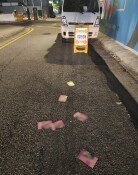Authorities to Ban Bicycling and Inline Skating at Cheonggyecheon
Authorities to Ban Bicycling and Inline Skating at Cheonggyecheon
Posted August. 29, 2005 03:07,
Ever since the Seoul Metropolitan Government decided not to impose fines for vandalism, illegal garbage disposal, fishing, and sleeping in the Cheonggyecheon area, worries are increasing over illegal activities there after the opening of the area on October 1.
The Seoul Metropolitan Government plans to present an ordinance on Cheonggyecheon use before the Seoul Metropolitan Council on August 30.
An official of the metropolitan government said on August 28 that the Seoul Metropolitan Facilities Management Corporation wanted to adopt a fine system in managing the Cheonggyecheon, but, at first, administrative guidance will be applied and an ordinance revision will be considered if problems continue. The metropolitan government plans to impose fines for illegal activities.
Focus on Administrative Guidance-
According to the proposed ordinance, the throwing-away of food, group events which do not have official permission, bicycles riding and in-line skating, and outdoor sleeping are banned on the Cheonggyecheon walk. People who walk their pets without a leash and do not pick up after them could be forced to go away as well. In addition, fishing will also be banned.
The proposed ordinance will go into effect if the council approves it when the Cheonggyecheon area officially opens on October 1st.
The official said banned activities such as bathing and fishing will be controlled by city agents using administrative guidance. However, the adoption of a fine system will be seriously considered if problems continue.
Vandalism Worries-
The Seoul Metropolitan Facilities Management Corporation concerned that management of the area will not be easy without fines.
The corporation said it is highly possible that the number of homeless people there and the amount of waste that needs to be taken care of there will increase after the opening.
Officials also said that Gwangtong Bridge, a structure in the area which was restored after 95 years would be designated as a national cultural asset. In particular, sub-structure relief work of the bridge could be damaged by frequent use by citizens.
An official of the Cheonggyecheon restoration project said that appreciation and touching would not cause problems, but management measures have been discussed in response to takbon (pressed copy of petroglyphs) or possible damage.
Tae-Hun Hwang beetlez@donga.com







